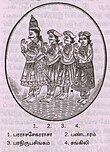Aryacakravarti
| Aryacakravarti | |
|---|---|
 |
|
| Country | Sri Lanka |
| Titles | Cinkaiariyan, Cetukavalan, Kangkaiariyarkoon |
| Founded | 1200s AD |
| Founder | Kulingai Cakravarti |
| Final ruler | Cankili II in Jaffna Kingdom |
| Dissolution | 1619 |
| Cadet branches | None |
The Aryacakravarti dynasty (Tamil: ஆரியச் சக்கரவர்த்திகள் வம்சம்) were kings of the Jaffna Kingdom in Sri Lanka. The earliest Sri Lankan sources, between 1277 and 1283, mention a military leader of this name as a minister in the services of the Pandyan Empire; he raided the western Sri Lankan coast and took the politically significant relic of the Buddha’s tooth from the Sinhalese capital city of Yapahuwa. Political and military leaders of the same family name left a number of inscriptions in the modern-day Tamil Nadu state, with dates ranging from 1272 to 1305, during the late Pandyan Empire. According to contemporary native literature, the family also claimed lineage from the Tamil Brahmins of the prominent Hindu pilgrimage temple of Rameswaram in the modern Ramanathapuram District of India. They ruled the Jaffna kingdom from the 13th until the 17th century, when the last of the dynasty, Cankili II, was ousted by the Portuguese.
The origins of the Aryacakravarti are claimed in contemporary court chronicles; modern historians offer some competing theories.
From the thirteenth-century inscriptions commemorating dignitaries calling themselves Aryacakravartis in present day Tamil Nadu we can deduce that they hailed from the coastal region of present day Ramanathapuram District, which they called Cevvirukkai Nadu. They administered land and held important military ranks. It is believed that most of them belonged to one family of Tamil Brahmins in the modern Ramanathapuram District who had become prominent during the days of the Pandyan king Maravarman Kulasekaran.
...
Wikipedia
